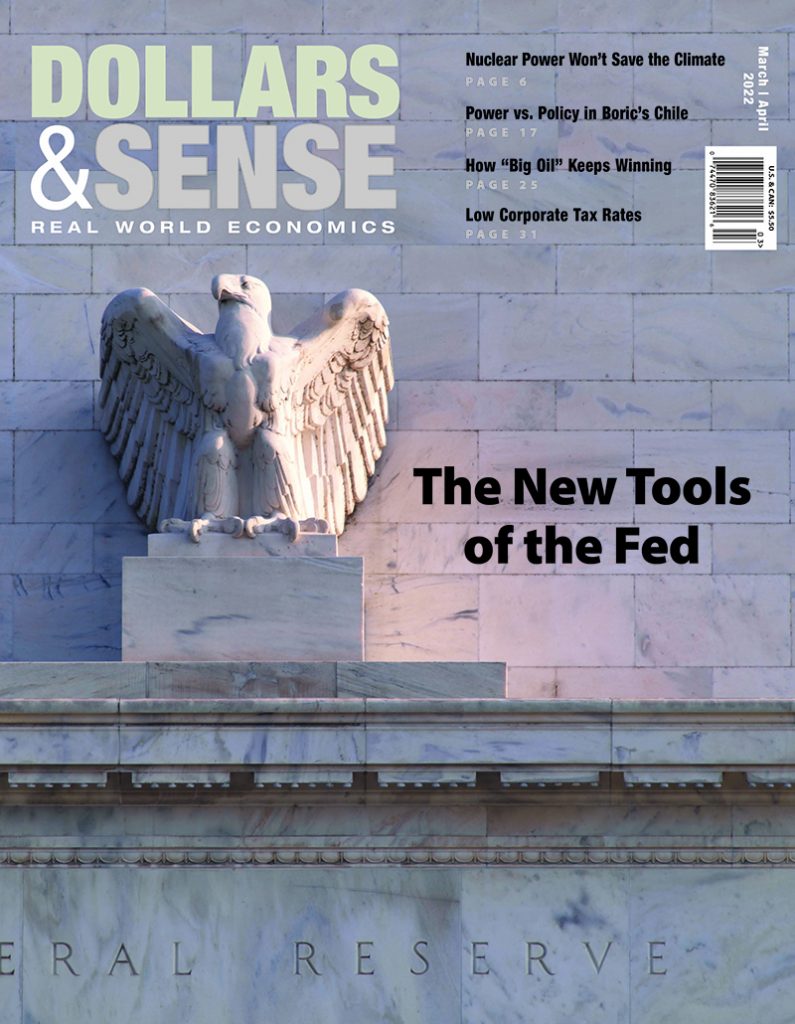Health Insurance for 20 Million is at Risk
If Congress fails to renew the ACA enhanced benefits, millions will be unable to access the health care they need.

Our March/April 2022 issue is at the printers and the digital version is poised to be sent to e-subscribers. We posted John Miller's cover story, "The New Tools of the Fed", yesterday, and Bob Pollin's comment, "Solving the Climate Crisis with Nuclear Energy Won’t Work", a few days ago. Here is the p. 2 editors' note for the issue:
Is There an Alternative?
As John Millerexplains in this issue’s cover story, the standard teaching about monetary policy in an introductory macroeconomics course was always misleading, but since the financial crisis of 2008–2009, it’s been alarmingly out of date. The economic crisis that resulted from the pandemic confirms as much. In addition, the new tools that the Federal Reserve has adopted to regulate interest rates have widened the gulf between the rich and the poor. The Fed now seems poised to “tighten the monetary spigot,” which, as Miller notes, “would slow the economy and cost working people their jobs.” Miller proposes an alternative to such monetary austerity: Tax the wealth of the people who have gained so much from the stock market-friendly Fed policies and use the proceeds for public spending that will “make growth more equitable and sustainable.”
Alternatives to the status quo—austerity and free-market solutions that serve the wealthy and hurt ordinary people and the planet—are a theme of this issue of Dollars & Sense. Two articles cite British Prime Minister Margaret Thatcher’s dictum that “There Is No Alternative” (TINA) to neoliberalism. James M. Cypher’s feature on Chile under its new president, Gabriel Boric, traces the history of the ideological alliance between Thatcher and Augusto Pinochet, who ruled Chile for 17 years, and TINA’s dominance in the neoliberal administrations that followed his regime. The massive protests in 2019 and 2020 demanded an alternative; Boric is poised to deliver it—if the powers that be let him. And Henry Williams, a participant in the D&S Writing Workshop, mentions TINA in his review of Anne Case and Angus Deaton’s Deaths of Despair and the Future of Capitalism. Case and Deaton document the devastating effects of free-market capitalism, but their blind spot—foreclosing the possibility of an alternative to free-market capitalism—means they are unable to identify free-market capitalism as the cause of those ills.
Naomi Oreskes and Jeff Nesbit explain “How ‘Big Oil’ Works the System and Keeps Winning.” Over the years, oil companies have managed to outmaneuver (or capture) regulators to keep profits rolling in, even in today’s era of climate catastrophe when it is imperative to convert to renewable sources of energy. The industry’s stranglehold is even more obvious in the wake of Russia’s invasion of Ukraine. The need to boycott Russian oil and gas should reinforce the alternative that climate change should already have made clear—the urgent need to shift to renewables. But fossil-fuel companies have such a stranglehold on policymakers that the Biden administration is instead figuring out how to provide different sources of oil and gas to wean Western Europe off Russian imports.
Russia’s invasion of Ukraine also has a lesson for the viability of nuclear power, as Robert Pollin shows in his Comment in this issue. It’s no surprise that vested interests like the nuclear industry want to push nuclear power as a solution to the climate crisis. And some reputable people, including some left commentators, support a nuclear alternative. As Pollin explains, the Ukraine invasion and the threat of disaster at the Chernobyl and Zaporizhzhia nuclear plants remind us of the risks that would come with the massive expansion of new reactors if nuclear energy were to be part of a climate solution. But there is an alternative—“a high-efficiency and renewables-dominant energy infrastructure can deliver a zero emissions global economy within 30 years.”
Also in this issue: Labor scholar Robert Ovetz shows how, even though the strikes many observers expected for last fall didn’t materialize, if we count credible strike threats, which have been effective at extracting concessions from employers, we can get a better picture of worker power. And Arthur MacEwan, aka “Dr. Dollar,” shows how corporations exercise their power to ensure low effective tax rates. The alternative to corporate-friendly tax policies has always been obvious. The way to bring about this alternative, MacEwan writes, is the same as always: “political organizing—through unions, community groups, student organizations, and other such groups—to overcome the great power that large firms exercise in our political system.”